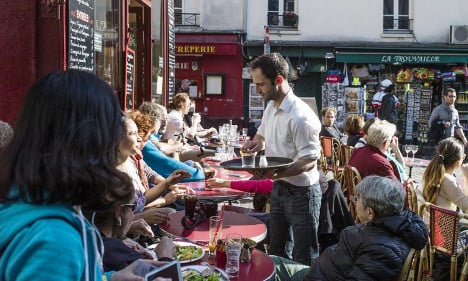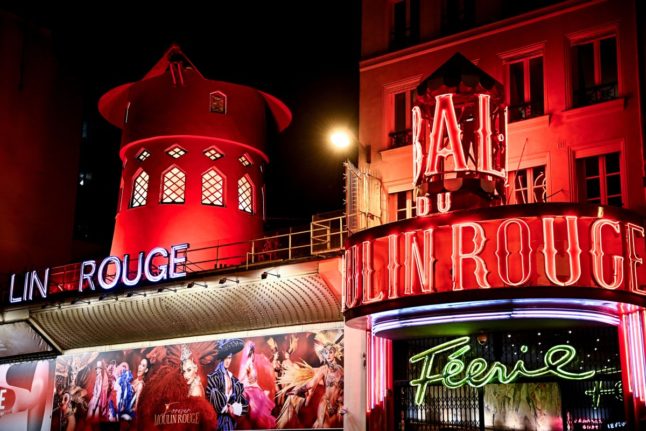After a long period of closures or restrictions during the pandemic, French café terrace life is back, and people are flocking to enjoy one of France’s greatest pleasures – loitering on a terrace while enjoying a coffee/glass of wine/beer and a chat with friends/good book/spot of people watching.
But there are some things you should know to maximise your terrace experience;
Don’t be a chair vulture
If the terrace is full, your best bet is to find a waiter and to tell them the size of your group. They’ll usually keep the next available table for you, even if other vultures are hanging out ready to snatch it.
If there are free seats at a terrace, then go ahead and plonk yourself down, but if the place looks busy then don’t take up a table for four if you are alone.
Check the cutlery
If you intend to only have a drink, then avoid the tables that have cutlery on them – they’re reserved for diners.
Usually terraces have spaces for drinkers only and spaces for people who intend to eat, and any table that has cutlery, menus or table-clothes is intended for eating.
If you can’t see any tables that aren’t set up with cutlery, ask the waiter.
If you do want to eat, bear in mind that many places will only serve food between the hours of 12 and 2 (for lunch) or 7 and 9 (for dinner). If you want to eat outside these hours, look for a place that advertises ‘service non-stop’.
Don’t start moving the furniture around
If there’s a big group of you, don’t just pile in and start moving the furniture around to suit your needs.
The waiter will usually be happy to create a space for you, but leave it to the staff to find the best space and set it up for you – you wouldn’t go into someone’s home and start moving the sofa to a different position.
Grab an outward-facing seat
If you’re alone then we highly recommend getting one of the seats that face outwards and then you enjoy one of the best pleasures of café terrace time – people watching
Keep your elbows in
In cities – especially Paris – space can be pretty tight on terraces as cafés try to maximise their revenue.
The lack of leg and elbow room can often cause problems for foreign visitors, who are often, shall we say, bigger, than the streamlined Parisians. But you’ll just have to cope if you want to enjoy the terrace atmosphere – and keep your elbows in so you don’t end up jabbing the person at the neighbouring table.
Also be prepared to shimmy between tables to get to your seat.
Be patient – wait to be served
French waiters are generally some of the best in the world, and they don’t need you to seek them out when you’re hungry or thirsty.
They’ll find you when they’re free, so don’t rush to head in to the bar if you think you’ve been forgotten. Foreigners often find that service in general is slower in France, but the flip side of that is that you won’t be rushed out the second you have swallowed the last mouthful of your drink.
Smoking is allowed . . .
It’s legal to smoke cigarettes on terraces in France, even if everyone around is tucking into their dinner at the same time. It’s not unheard of for French people to ask neighbours if they’re okay with a burning cigarette, so if you are lighting up perhaps do the same. It’s considered polite to hold the cigarette away from the tables, however, between puffs.
However bear in mind that the terrace is the smoking area, so if cigarette smoke really bothers you then you might be best to take a seat indoors, where smoking is prohibited.
. . . and so are dogs
Dogs are allowed on virtually all café terraces, so if you really don’t like being around dogs then perhaps a terrace is not the place for you.
Waiters usually bring them a bowl of water and generally make them welcome and before moving around the terrace it’s best to check that there isn’t a small dog under the table (Parisians in particularly like their pooches pocket-sized) so you don’t accidentally tread on a good boy’s paws.
Keep quiet
Even if you’re in a bustling bar, the French won’t be impressed if you’re speaking or laughing too loudly with your friends (which is often the case for over-excited Anglos). In fact, don’t be surprised if your French neighbours ask you to be quiet, complain to a waiter, or even move to another seat.
It’s just not the French way to be noisy, so be sure to respect the moderation too.
Don’t feel the pressure to leave
And lastly, French terraces are made to be enjoyed – don’t feel like you have to leave the second you’ve finished your drink. In fact, many people will have a long and leisurely people-watching session when they’re out en terrasse, so you shouldn’t feel bad about doing the same and it’s perfectly acceptable to spend a couple of hours on the terrace with nothing more than a single €1.50 coffee.
If the waiter comes out to ask if you’d like another drink, feel free to shrug them off – especially if the terrace isn’t full. But it’s perhaps time to call it a day if the waiter comes out asking again. Or, of course, you could order another drink and enjoy the terrace some more.



 Please whitelist us to continue reading.
Please whitelist us to continue reading.
Do people actually get paid to write this garbage?
I fully agree.
I have lived in France for several years and I find most of what is said to be rubbish. I strongly suspect that this writer has hardly stepped outside Paris.
What part(s) are rubbish?
From my experience, it’s totally accurate.
After all this endless list of restrictive-sounding stuff I can only say frankly it’s all obvious good manners that apply in London or anywhere else.
Also, please leave the smartphone alone. Texting and searching are okay, but loudmouth phone conversations are interdit! La terrace is not your private phone booth. Laptops look dopey, too, so avoid them. Also, do whatever grooming you do at HOME. Makeup, flossing, hair, changing clothes, etc., are all better done elsewhere, please. One chair per customer; keep your damn feet off the furniture! Leave your luggage at the hotel; bags of new merchandise from top boutiques are okay, but not your weekly grocery or car parts. Small outside snacks are okay, but the terrace is not your personal picnic ground. Read the terrace and only speak with your neighbor if it is mutual. Guys, the terrace is not a meat market or pickup joint; be polite and discreet. Finally, if so inclined, feel free to enjoy your table as long as you want, really, as long as you want.
P.S. These are certainly NOT “obvious good manners” and are highly specific to France. Don’t believe it? Just break one of these etiquette rules and see how long you last before you get summarily bounced.